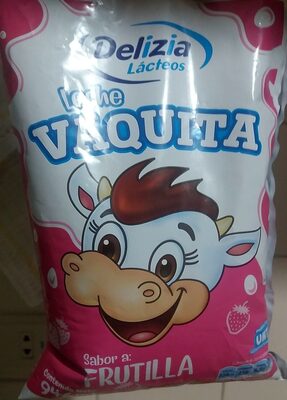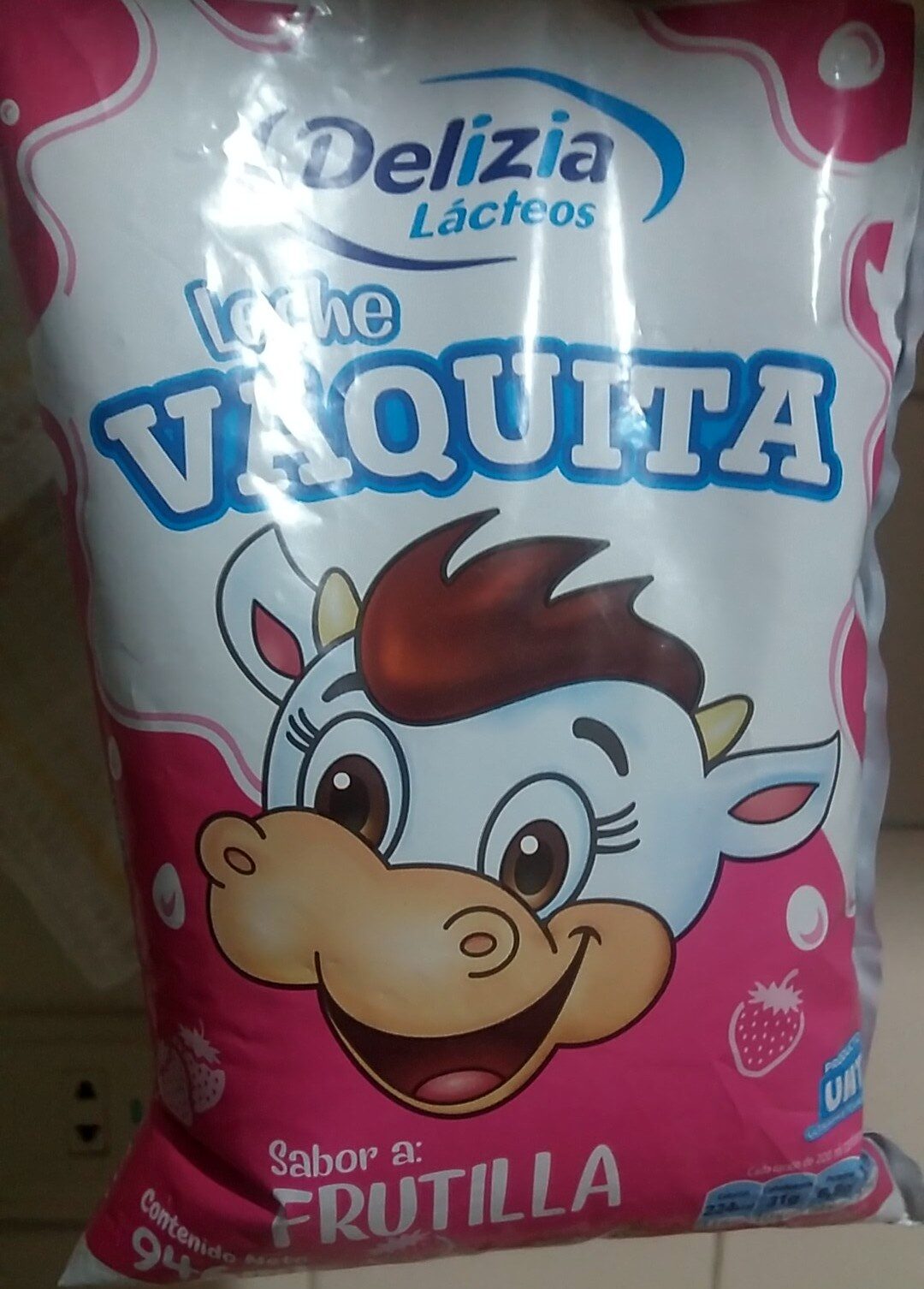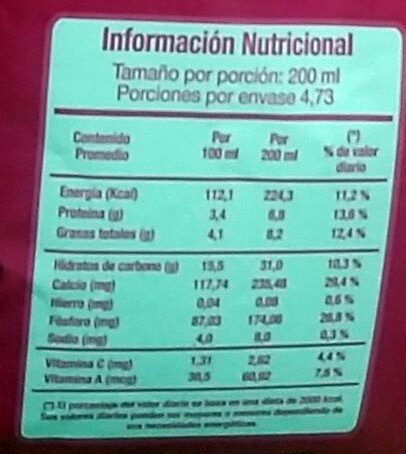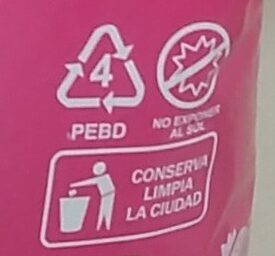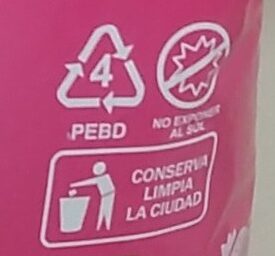Help us make food transparency the norm!
As a non-profit organization, we depend on your donations to continue informing consumers around the world about what they eat.
The food revolution starts with you!
Leche Vaquita sabor Frutilla - 946 ml
Leche Vaquita sabor Frutilla - 946 ml
Barcode: 7771224009256 (EAN / EAN-13)
Common name: leche saborizada frutilla.
Quantity: 946 ml
Packaging: Plastic, PE 7 - Polyethylene, LDPE 4 - Low-density polyethylene, Bag
Categories: Beverages, Dairies, Dairy drinks, Milks, Flavoured milks, Homogenized milks, UHT Milks, Whole milks, Cow milks
Labels, certifications, awards: es:Hecho en Bolivia, es:UHT
Origin of ingredients: Bolivia
Manufacturing or processing places: El Alto, La Paz, Cotoca, Santa Cruz, Bolivia
Traceability code: 040103190001, 080103030003
Link to the product page on the official site of the producer: https://www.delizia.com.bo/
Stores: Delizia
Countries where sold: Bolivia
Matching with your preferences
Health
Ingredients
-
13 ingredients
: Leche entera, leche descremada en polvo, azúcar, estabilizantes (SIN-471, SIN-401, SIN-407), maltodextrina, regulador de la acidez (SIN-331iii), colorante (SIN-120), saborizante artificial frutilla.Allergens: Milk
Food processing
-
Ultra processed foods
Elements that indicate the product is in the 4 - Ultra processed food and drink products group:
- Additive: E120 - Cochineal
- Additive: E401 - Sodium alginate
- Additive: E407 - Carrageenan
- Additive: E471 - Mono- and diglycerides of fatty acids
- Ingredient: Colour
- Ingredient: Maltodextrin
Food products are classified into 4 groups according to their degree of processing:
- Unprocessed or minimally processed foods
- Processed culinary ingredients
- Processed foods
- Ultra processed foods
The determination of the group is based on the category of the product and on the ingredients it contains.
Additives
-
E120 - Cochineal
Carminic acid: Carminic acid -C22H20O13- is a red glucosidal hydroxyanthrapurin that occurs naturally in some scale insects, such as the cochineal, Armenian cochineal, and Polish cochineal. The insects produce the acid as a deterrent to predators. An aluminum salt of carminic acid is the coloring agent in carmine. Synonyms are C.I. 75470 and C.I. Natural Red 4. The chemical structure of carminic acid consists of a core anthraquinone structure linked to a glucose sugar unit. Carminic acid was first synthesized in the laboratory by organic chemists in 1991.Source: Wikipedia
-
E331 - Sodium citrates
Sodium citrate: Sodium citrate may refer to any of the sodium salts of citrate -though most commonly the third-: Monosodium citrate Disodium citrate Trisodium citrateThe three forms of the salt are collectively known by the E number E331. Sodium citrates are used as acidity regulators in food and drinks, and also as emulsifiers for oils. They enable cheeses to melt without becoming greasy.Source: Wikipedia
-
E331iii - Trisodium citrate
Sodium citrate: Sodium citrate may refer to any of the sodium salts of citrate -though most commonly the third-: Monosodium citrate Disodium citrate Trisodium citrateThe three forms of the salt are collectively known by the E number E331. Sodium citrates are used as acidity regulators in food and drinks, and also as emulsifiers for oils. They enable cheeses to melt without becoming greasy.Source: Wikipedia
-
E407 - Carrageenan
Carrageenan (E407), derived from red seaweed, is widely employed in the food industry as a gelling, thickening, and stabilizing agent, notably in dairy and meat products.
It can exist in various forms, each imparting distinct textural properties to food.
However, its degraded form, often referred to as poligeenan, has raised health concerns due to its potential inflammatory effects and its classification as a possible human carcinogen (Group 2B) by the International Agency for Research on Cancer (IARC).
Nevertheless, food-grade carrageenan has been deemed safe by various regulatory bodies when consumed in amounts typically found in food.
-
E471 - Mono- and diglycerides of fatty acids
Mono- and diglycerides of fatty acids (E471), are food additives commonly used as emulsifiers in various processed foods.
These compounds consist of glycerol molecules linked to one or two fatty acid chains, which help stabilize and blend water and oil-based ingredients. E471 enhances the texture and shelf life of products like margarine, baked goods, and ice cream, ensuring a smooth and consistent texture.
It is generally considered safe for consumption within established regulatory limits.
Ingredients analysis
-
May contain palm oil
Ingredients that may contain palm oil: E471
-
Non-vegan
Non-vegan ingredients: Whole milk, Skimmed milk powder, E120Some ingredients could not be recognized.
We need your help!
You can help us recognize more ingredients and better analyze the list of ingredients for this product and others:
- Edit this product page to correct spelling mistakes in the ingredients list, and/or to remove ingredients in other languages and sentences that are not related to the ingredients.
- Add new entries, synonyms or translations to our multilingual lists of ingredients, ingredient processing methods, and labels.
If you would like to help, join the #ingredients channel on our Slack discussion space and/or learn about ingredients analysis on our wiki. Thank you!
-
Non-vegetarian
Non-vegetarian ingredients: E120Some ingredients could not be recognized.
We need your help!
You can help us recognize more ingredients and better analyze the list of ingredients for this product and others:
- Edit this product page to correct spelling mistakes in the ingredients list, and/or to remove ingredients in other languages and sentences that are not related to the ingredients.
- Add new entries, synonyms or translations to our multilingual lists of ingredients, ingredient processing methods, and labels.
If you would like to help, join the #ingredients channel on our Slack discussion space and/or learn about ingredients analysis on our wiki. Thank you!
-
Details of the analysis of the ingredients
We need your help!
Some ingredients could not be recognized.
We need your help!
You can help us recognize more ingredients and better analyze the list of ingredients for this product and others:
- Edit this product page to correct spelling mistakes in the ingredients list, and/or to remove ingredients in other languages and sentences that are not related to the ingredients.
- Add new entries, synonyms or translations to our multilingual lists of ingredients, ingredient processing methods, and labels.
If you would like to help, join the #ingredients channel on our Slack discussion space and/or learn about ingredients analysis on our wiki. Thank you!
: Leche entera, leche descremada en polvo, azúcar, estabilizantes (e471, e401, e407), maltodextrina, regulador de la acidez (e331iii), colorante (e120), saborizante artificial frutilla- Leche entera -> en:whole-milk - vegan: no - vegetarian: yes - ciqual_food_code: 19023 - percent_min: 12.5 - percent_max: 100
- leche descremada en polvo -> en:skimmed-milk-powder - vegan: no - vegetarian: yes - ciqual_food_code: 19054 - percent_min: 0 - percent_max: 50
- azúcar -> en:sugar - vegan: yes - vegetarian: yes - ciqual_proxy_food_code: 31016 - percent_min: 0 - percent_max: 33.3333333333333
- estabilizantes -> en:stabiliser - percent_min: 0 - percent_max: 25
- e471 -> en:e471 - vegan: maybe - vegetarian: maybe - from_palm_oil: maybe - percent_min: 0 - percent_max: 25
- e401 -> en:e401 - vegan: yes - vegetarian: yes - percent_min: 0 - percent_max: 12.5
- e407 -> en:e407 - vegan: yes - vegetarian: yes - percent_min: 0 - percent_max: 8.33333333333333
- maltodextrina -> en:maltodextrin - vegan: yes - vegetarian: yes - percent_min: 0 - percent_max: 20
- regulador de la acidez -> en:acidity-regulator - percent_min: 0 - percent_max: 16.6666666666667
- e331iii -> en:e331iii - vegan: yes - vegetarian: yes - percent_min: 0 - percent_max: 16.6666666666667
- colorante -> en:colour - percent_min: 0 - percent_max: 14.2857142857143
- e120 -> en:e120 - vegan: no - vegetarian: no - percent_min: 0 - percent_max: 14.2857142857143
- saborizante artificial frutilla -> es:saborizante-artificial-frutilla - percent_min: 0 - percent_max: 12.5
Nutrition
-
Missing data to compute the Nutri-Score
Missing nutrition facts
⚠ ️The nutrition facts of the product must be specified in order to compute the Nutri-Score.Could you add the information needed to compute the Nutri-Score? Add nutrition facts
-
Nutrient levels
-
Fat in moderate quantity (4.1%)
What you need to know- A high consumption of fat, especially saturated fats, can raise cholesterol, which increases the risk of heart diseases.
Recommendation: Limit the consumption of fat and saturated fat- Choose products with lower fat and saturated fat content.
-
Salt in low quantity (0.01%)
What you need to know- A high consumption of salt (or sodium) can cause raised blood pressure, which can increase the risk of heart disease and stroke.
- Many people who have high blood pressure do not know it, as there are often no symptoms.
- Most people consume too much salt (on average 9 to 12 grams per day), around twice the recommended maximum level of intake.
Recommendation: Limit the consumption of salt and salted food- Reduce the quantity of salt used when cooking, and don't salt again at the table.
- Limit the consumption of salty snacks and choose products with lower salt content.
-
-
Nutrition facts
Nutrition facts As sold
for 100 g / 100 mlPrepared
for 100 g / 100 mlPrepared
per serving (200 ml)Compared to: Cow milks Energy 469 kj
(112 kcal)469 kj
(112 kcal)938 kj
(224 kcal)+114% Fat 4.1 g 4.1 g 8.2 g +86% Saturated fat ? ? ? Carbohydrates 15.5 g 15.5 g 31 g +224% Sugars ? ? ? Fiber ? ? ? Proteins 3.4 g 3.4 g 6.8 g +5% Salt 0.01 g 0.01 g 0.02 g -91% Vitamin A 30.5 µg 30 µg 60.1 µg -61% Vitamin C (ascorbic acid) 1.31 mg 1.31 mg 2.62 mg +14% Calcium 117.74 mg 118 mg 235.48 mg -1% Phosphorus 87.03 mg 87 mg 174.06 mg -10% Iron 0.04 mg 0.04 mg 0.08 mg -5% Fruits‚ vegetables‚ nuts and rapeseed‚ walnut and olive oils (estimate from ingredients list analysis) 0 % ? ?
Environment
-
Eco-Score D - High environmental impact
⚠ ️Select a country in order to include the full impact of transportation.The Eco-Score is an experimental score that summarizes the environmental impacts of food products.→ The Eco-Score was initially developped for France and it is being extended to other European countries. The Eco-Score formula is subject to change as it is regularly improved to make it more precise and better suited to each country.Life cycle analysis
-
Average impact of products of the same category: C (Score: 52/100)
Category: Milk, whole, pasteurised
Category: Milk, whole, pasteurised
- PEF environmental score: 0.14 (the lower the score, the lower the impact)
- including impact on climate change: 1.50 kg CO2 eq/kg of product
Stage Impact Agriculture
74.4 %Processing
1.0 %Packaging
10.1 %Transportation
11.2 %Distribution
3.3 %Consumption
0.0 %
Bonuses and maluses
-
Origins of ingredients with a high impact
Malus: -5
Environmental policy: -5
Transportation: 0
Origin of the product and/or its ingredients % of ingredients Impact Bolivia 100 %High
-
Packaging with a medium impact
Malus: -8
Shape Material Recycling Impact 1 Bag LDPE 4 - Low-density polyethylene Recycle High
Eco-Score for this product
-
Impact for this product: D (Score: 39/100)
Product: Leche Vaquita sabor Frutilla - 946 ml
Life cycle analysis score: 52
Sum of bonuses and maluses: -13
Final score: 39/100
-
Carbon footprint
-
Equal to driving 0.8 km in a petrol car
150 g CO² per 100g of product
The carbon emission figure comes from ADEME's Agribalyse database, for the category: Milk, whole, pasteurised (Source: ADEME Agribalyse Database)
Stage Impact Agriculture
74.7 %Processing
0.7 %Packaging
9.9 %Transportation
13.7 %Distribution
1.0 %Consumption
0.0 %
Packaging
-
Packaging with a medium impact
-
Packaging parts
1 x Bag (LDPE 4 - Low-density polyethylene)
-
Packaging materials
Material % Packaging weight Packaging weight per 100 g of product Plastic
-
Transportation
-
Origins of ingredients
Origins of ingredients with a high impact
Origin of the product and/or its ingredients % of ingredients Impact Bolivia 100 %High
Report a problem
-
Incomplete or incorrect information?
Category, labels, ingredients, allergens, nutritional information, photos etc.
If the information does not match the information on the packaging, please complete or correct it. Open Food Facts is a collaborative database, and every contribution is useful for all.
Data sources
Product added on by 5m4u9
Last edit of product page on by 5m4u9.
Product page also edited by roboto-app.
